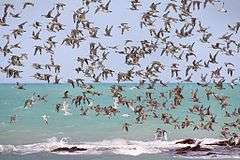Godwit
| Godwits | |
|---|---|
 | |
| Black-tailed godwit in front and bar-tailed godwit behind | |
| Scientific classification | |
| Kingdom: | Animalia |
| Phylum: | Chordata |
| Class: | Aves |
| Order: | Charadriiformes |
| Family: | Scolopacidae |
| Genus: | Limosa Brisson, 1760 |
| Species | |
|
4, see text. | |
The godwits are a group of large, long-billed, long-legged and strongly migratory waders of the bird genus Limosa. Their long bills allow them to probe deeply in the sand for aquatic worms and molluscs. They frequent tidal shorelines, breeding in northern climates in summer and migrating south in winter. In their winter range, they flock together where food is plentiful. A female bar-tailed godwit holds the record for the longest non-stop flight for a land bird.[1]
They can be distinguished from the curlews by their straight or slightly upturned bills, and from the dowitchers by their longer legs. The winter plumages are fairly drab, but three species have reddish underparts when breeding. The females are appreciably larger than the males.
Godwits were once a popular British dish. Sir Thomas Browne writing in about 1682 noted that godwits "were accounted the daintiest dish in England".[2]
The English name was first recorded in about 1416–7 and is believed to imitate the bird's call.[2] The genus name Limosa is from Latin and means "muddy", from limus, "mud".[3]

Extant species
- Black-tailed godwit, Limosa limosa
- Hudsonian godwit, Limosa haemastica
- Bar-tailed godwit, Limosa lapponica
- Marbled godwit, Limosa fedoa
Fossil species
In addition, there are two or three species of fossil prehistoric godwits. Limosa vanrossemi is known from the Monterey Formation (Late Miocene, approx. 6 mya) of Lompoc, United States. Limosa lacrimosa is known from the Early Pliocene of Western Mongolia (Kurochkin, 1985). Limosa gypsorum of the Late Eocene (Montmartre Formation, some 35 mya) of France may have actually been a curlew or some bird ancestral to both curlews and godwits (and possibly other Scolopacidae), or even a rail, being placed in the monotypic genus Montirallus by some (Olson, 1985). Certainly, curlews and godwits are rather ancient and in some respects primitive lineages of scolopacids, further complicating the assignment of such possibly basal forms.[4]
In a 2001 study comparing the ratios cerebrum to brain volumes in various dinosaur species, Hans C. E. Larsson found that more derived dinosaurs generally had proportionally more voluminous cerebrum.[5] Limosa gypsorum, then regarded as a Numenius species, was a discrepancy in this general trend.[6] L. gypsorum was only 63% of the way between a typical reptilian ratio and that of modern birds.[6] However, this may be explainable if the endocast was distorted, as it had been previously depicted in the past by Deschaseaux, who is described by Larsson as calling the endocast "slightly anteroposteriorly sheared and laterally compressed."[6]
Footnotes
- ↑ Bird Completes Epic Flight Across The Pacific ScienceDaily.com
- 1 2 "Godwit". Oxford English Dictionary (3rd ed.). Oxford University Press. September 2005. (Subscription or UK public library membership required.)
- ↑ Jobling (2010) p. 227
- ↑ Thomas, Gavin H.; Wills, Matthew A. & Székely, Tamás (2004): "A supertree approach to shorebird phylogeny".BMC Evol. Biol. 4: 28. doi:10.1186/1471-2148-4-28 PMID 15329156 Supplementary Material
- ↑ "Allometric Comparison," in Larsson (2001). Pg. 27.
- 1 2 3 "Allometric Comparison," in Larsson (2001). Pg. 30.
References
- Jobling, James A (2010). The Helm Dictionary of Scientific Bird Names. London: Christopher Helm. ISBN 978-1-4081-2501-4.
- Larsson, H. C. E. 2001. Endocranial anatomy of Carcharodontosaurus saharicus (Theropoda: Allosauroidea) and its implications for theropod brain evolution. pp. 19–33. In: Mesozoic Vertebrate Life. Ed.s Tanke, D. H., Carpenter, K., Skrepnick, M. W. Indiana University Press.
- Olson, Storrs L. (1985): Section X.D.2.b. Scolopacidae. In: Farner, D.S.; King, J.R. & Parkes, Kenneth C. (eds.): Avian Biology 8: 174-175. Academic Press, New York.
- Gill, R. E. Jr; Piersma, T.; Hufford, G.; Servranckx, R.; Riegen, A. (2005). "Crossing the ultimate ecological barrier: evidence for an 11,000-km-long non-stop flight from Alaska to New Zealand and Eastern Australia by Bar-tailed Godwits". Condor. 107: 1–20. doi:10.1650/7613.